Final Report
Rieka's Final Report
Arrival in Japan
Before the training, I had no knowledge of the Duskin Leadership Training Program. It was my senior, Galuh Sukmara, an alumnus of the 2nd Duskin Leadership Training Program, who suggested that I apply for the program in 2020. However, the COVID-19 pandemic struck that same year, and World Health Organization (WHO)’s banned on international flights caused a delay in the delegate recruitment process. The recruitment process resumed in 2023, and I successfully met the requirements, passing both the selection test and interview. Finally, I was able to travel abroad for the first time. I flew from Yogyakarta, Indonesia, to Osaka, Japan, with a transit in Singapore. I arrived in Kansai Airport on October 23, 2023.
After just one day in Japan, I noticed many differences between Japan and Indonesia. For instance, the greeting style: Indonesians either press their palms together or place their right hand on their left chest, whereas the Japanese bow. Indonesia has two seasons, the dry season and the rainy season, while Japan has four seasons: spring, summer, autumn and winter. Another remarkable experience for me was witnessing Japan's cleanliness, orderliness, and inclusivity. People of various disabilities were moving around independently. Even in crowded public places, I saw people queueing up. The cleanliness of Japanese toilets is extraordinary. Incredible! I have also visited several tourist spots with different educational themes. It’s been amazing! I am from Indonesia, and other trainees were from Sri Lanka and Bangladesh. There was a female participant from Sri Lanka with a visual impairment (Stargardt’s Macular Dystrophy), and a male participant from Bangladesh with a physical disability (Charcot-Marie-Tooth disease).
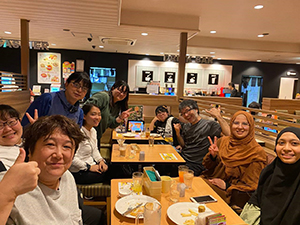
Japanese Language and Japanese Sign Language
Before arriving in Japan, I studied writing Hiragana, Katakana, and also JSL (Japanese Sign Language) through eight Zoom meetings. After that, I learned Japanese and JSL directly for three months with both hearing teachers and Deaf teachers. The lessons continued to focus on writing Hiragana, Katakana, and Kanji. I found it somewhat difficult to remember Japanese grammar. However, the Deaf teacher consistently introduced new sign language vocabulary and encouraged me to practice reading and writing longer sentences in Japanese. The Japanese language and JSL classes helped me interact more easily and quickly with the local community. My JSL skills are better than my Japanese language skills, but I will continue to learn both.
Homestay
In Saga Prefecture, I stayed at the home of a Japanese family for a week. The New Year celebrations at the Inoue family's home was truly enjoyable, with guests Hiroshi-san and Miyabi-san who were also guests like me. I loved the rural Japanese countryside atmosphere because it soothes the heart and the mind, and I could breathe in the natural air. We shared many stories about student exchanges and began to feel like family to one another. Inoue-san works as a fisherman and usually returns home with raw fish which are then cooked at home. During my stay, I had a chance to taste whale meat caught by Inoue-san. It was my first experience eating boiled whale meat. Indonesia also has whales, but they are a protected species and catching and eating them is prohibited.
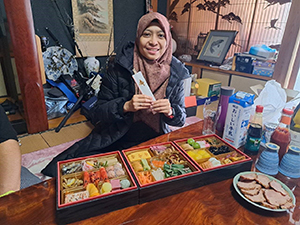
My Experience
1. Duskin Museum
At the Duskin Museum, I had the opportunity to make donuts, and observe the entire process of making donuts. The donuts came in various shapes and flavors with chocolate or vanilla toppings, which could be customized to taste. I underwent training alongside other participants and the JSRPD team (Japanese Society for Rehabilitation of Persons with Disabilities). It was incredibly enjoyable and exciting!
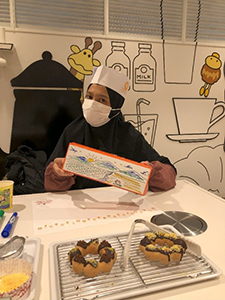
2. Skiing Class
For the first time, I tried skiing in Niigata for two days, accompanied by skiing instructors, fellow trainees, and the JSRPD team. It was so much fun!! It was also my first time touching snow, which felt like shaved ice.
Individual Training
JASS (Japanese ASL Signers Society), Tokyo.
My training was on presentation skills from start to finish, learning about databases, how to stand when one gives a presentation, how to give sign language presentations in front of an audience, and more. It taught me how deaf people could give presentations, in ways that are different from hearing people. This helped me improve my presentation abilities.
Deaf Network Kagoshima
Deaf Net. KAGOSHIMA runs four businesses. One is Deaf Kids. After classes at deaf schools, children come to Deaf Kids to do homework, play together, and enjoy chatting. The staff communicate with the children in sign language so children are able to understand everything they say. The second business was Budo-no-Ki, a place where elderly deaf people and people who were deaf but also had other disabilities made handicrafts. Budo-no-Ki functioned not only as a place for work, but also as a place where the members could enjoy talking to one another in sign language. The third business was Satsuma Waffle. Again, deaf people, and deaf people also with other disabilities were at work, communicating in sign language. They were being paid and living ordinarily. This made me realize how important it is that there are places for deaf people to work with a sense of security. I tried my hand at making waffles myself, they were exceptionally good. The third business is group home. The buildings were separate for men and women, with deafblind residents. The residents had left home from their parents to become independent and were gradually learning to do more things on their own such as cleaning and doing laundry, step by step. It was especially worth noting that all the leaders of Deaf Net. KAGOSHIMA’s wide-ranging businesses were all deaf.
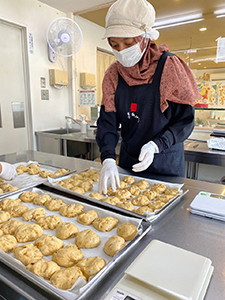
Osaka Prefecture Welfare Information and Communication Center
This organization has a structure where Deaf and hearing leaders collaborate effectively.
Comekko
Comekko is a place where deaf infants and young children can learn sign language through fun activity. I was particularly interesting that Comekko was supporting not just deaf children but their parents too. For instance, they were providing sign language classes to parents to help them communicate with their children at home. They also offer consultations for parents to address their concerns that arise as they raise deaf children.
Meisei Gakuen, Tokyo
I knew about bilingual-education Meisei Gakuen even before coming to Japan. My training at Meisei Gakuen was mostly with its preschool (4-5 years olds) division. I was astonished to see how the children were competent in sign language and able to talk about various subjects. There were these preschool children to junior high school students at Meisei Gakuen, who were interacting with one another regardless of age or faculty which I found was very appealing.
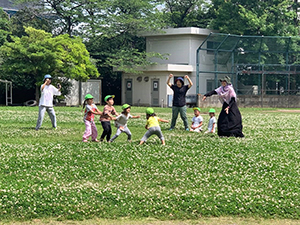
The goal of my training was to learn about deaf children were being instructed in Japan and how parents with deaf children were managing. There were two things I noticed that were different between Indonesia and Japan.
First, the availability of places where children could learn in sign language. Indonesia does not have schools where deaf children can learn in sign language. In Japan, deaf teachers teach such children in sign language. The children were watching the teachers explaining and asking questions. The advantage of providing education in this interactive manner is that lessons can move forward with teachers checking whether children are understanding what they are being taught. In Indonesia, teachers are teaching without realizing that children are not really following.
The second difference is the availability of consultations and support. Japan has places for parents to consult how to raise deaf children, when their children turn out to be deaf. Through such consultations, parents realize that they can communicate with their children in sign language and are also able to access places to learn sign language. Indonesia does not offer such consultations or support. There are many children in Indonesia who become stay-at-home recluses because they are unable to communicate with their family members and bottle up their feelings.
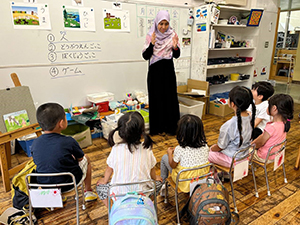
Future Plans
My future plan is to create a program where parents and Deaf children can have a place for consultations. Additionally, I aim to continue building schools or learning centers for the Deaf. This idea emerged when I saw how many Deaf children of various ages at Meisei Gakuen could easily communicate with other Deaf individuals, whether they were older or peers. I believe that raising awareness about using sign language and communicating with Deaf children across Indonesia is crucial because it contributes to early education. It is especially important for parents of Deaf children to learn and communicate using sign language for daily communication. Additionally, I will do my best to help people with disabilities find solutions to their challenges. Bismillah.
Conclusion
Throughout my participation in various activities of the Duskin program, I experienced many enlightening moments, both in group and individual training sessions. During my time in Japan, I gained numerous new experiences, knowledge, and insights. I feel inspired by the wealth of knowledge I have acquired and hope to share this inspiration with others, aspiring to become the best leader I can be. The positive motivation and support I received from many Japanese individuals, especially from Duskin, have fueled my enthusiasm.
I extend my heartfelt gratitude to the Duskin Ainowa Foundation and JSRPD for providing me with such invaluable opportunities during my training in Japan. I hope to maintain and strengthen these bonds of friendship and collaboration formed during both group and individual training experiences.




